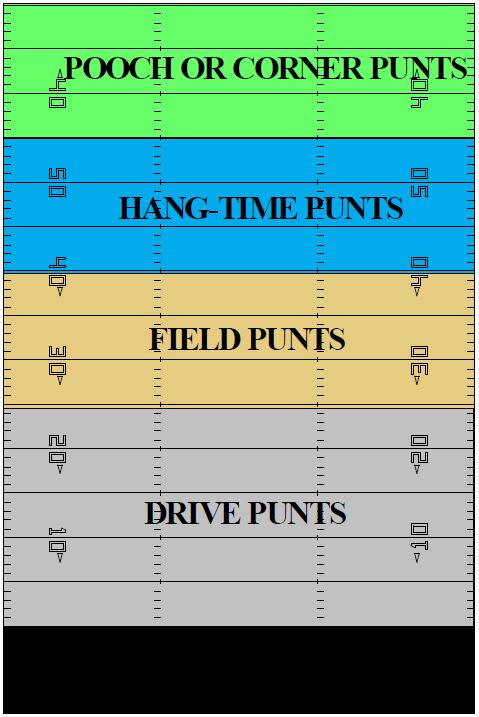KICKING GAME – PUNT TEAM (BOMB SQUAD)
The punt team (“BOMB SQUAD”) must develop expertise, precision and teamwork. Again, the talents of the snapper, punter and gunners will directly impact the types of schemes that will be used during a season. We must always gain forty (40) yards of field position when we punt. Field position is a critical factor to success in any game. The punt team generally creates field position through coverage and/or punt placement [pooch or directional punt]. The effectiveness has a direct impact on the type of offense or defense that can be used. George Allen said, “I emphatically believe that the punt is the most important play in football!” Here is a brief recap of the importance of the punt:
• A sizeable amount of yardage is exchanged
• There is a change in possession during live play
o An interception, or fumble picked up, are the only other way the ball changes possession during a live play
• It creates field position for the defense
• There is a momentum shift with a great punt, big hit or a turnover
o Field position can lead to momentum which can be turned into points, that can lead to victory
Our punt approach is to stress the return team through formation and kick placement. We use a spread punt alignment because we feel it limits the types of rushes we see. We feel that the spread punt alignment gives us the greatest chance to gain a field position advantage. Some of the reasons include:
• Utilization of personnel – use our skill players who can protect and cover.
• Stress the return team – this formation eliminates many of the traditional punt block schemes because of the potential fakes. Also, getting into the return schemes are slowed down because the return team must “check” for fake first.
• Strong coverage – gunners are key, and interior coverage is excellent because the return team is spread out.
• Precise protection rules – the protection scheme is well defined, and the players should have a clear picture of who to block.
The spread punt alignment is very consistent with our basic philosophy – protection, then coverage. Protection is based upon man blocking principles, with a zone scheme in an overload situation. We are going to directional kick for many of the same reasons detailed in the proceeding chapter. A directional kick, should take half the field away which allows our gunners to take specific aiming points. In general we want to kick away from a single returner. If our opponents have two (2) returners, we will consider a fake, and then we want to kick it as high and deep as possible.
In summary, an effective punting game is built with tough, physical players that are well prepared in scheme and fundamentals. The Bomb Squad goals include:
• Error Free – no penalties or missed assignments
o Do not have punt blocked
• Minimize returns
o Force punt returner to fair catch
o Hold the punt returner to under five yards
o Allow no touchdowns during the season
• Forty-yards of field position change
o Down all punts from the 50-yard line and in, inside the 20-yard line
Special teams play is about possessing the ball and field position. The punter plays an important role in these areas, especially field position. He must be cognizant of field position each time the Bomb Squad is on the field. As such we teach situational or field position punting. The punter must be able to execute four types of situational punts:
SITUATIONAL PUNTING

Pooch or Corner Punt: These are punts that are designed to pin the opponent inside the 20-yard line. The punts are designed to either go out of bounds inside the 20-yard line (Corner Punt) or come to rest, or downed inside the 20-yard line (Pooch Punt).
Hang-Time Punts: This is a punt that has more height than distance. The field position is such that the opponent may be concerned with possible fakes, so there is typically a minimal rush. This punt is designed to force the returner to fair catch the punt.
Field Punts: This is a punt that has equal distance and height. The goal is to prevent or minimize the return.
Drive Punts: This is a punt that has more distance than height. Also, when backed-up, the punter must be able to execute this punt with a 2-step approach. Coverage in these situations must be over-emphasized.
About the Author of this post:
Jerry Campbell has over 30 years of high school and college coaching experience. He has experience as a head coach, offensive coordinator, and various position coaches. He has written numerous football coaching articles in various publications, is the author of over 30 books on coaching football, and has produced 12 coaching video series. Additionally, he is a nationally sought after speaker on the coaching clinic circuit.